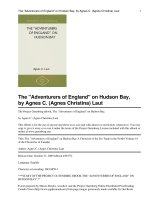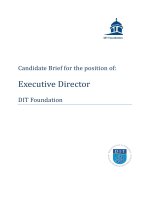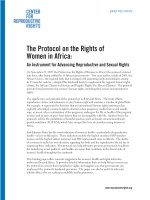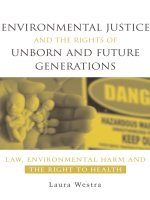Environmental Justice and the Rights of Unborn and Future Generations pot
Bạn đang xem bản rút gọn của tài liệu. Xem và tải ngay bản đầy đủ của tài liệu tại đây (2.16 MB, 345 trang )
Environmental Justice and the Rights
of Unborn and Future Generations
Environmental Justice and the Rights
of Unborn and Future Generations
Law, Environmental Harm and the Right to Health
Laura Westra
London • Sterling, VA
E
A
R
T
H
S
C
A
N
First published by Earthscan in the UK and USA in 2006
Copyright © 2006, Laura Westra
All rights reserved
ISBN-10: 1-84407-366-1
ISBN-13: 978-1-84407-366-5
Typeset by JS Typesetting Ltd, Porthcawl, Mid Glamorgan
Printed and bound in the UK by Bath Press
Cover design by Andrew Corbett
For a full list of publications please contact:
Earthscan
8–12 Camden High Street
London, NW1 0JH, UK
Tel: +44 (0)20 7387 8558
Fax: +44 (0)20 7387 8998
Email:
Web: www.earthscan.co.uk
22883 Quicksilver Drive, Sterling, VA 20166-2012, USA
Earthscan is an imprint of James and James (Science Publishers) Ltd and publishes in
association with the International Institute for Environment and Development
A catalogue record for this book is available from the British Library
Library of Congress Cataloging-in-Publication Data
Westra, Laura.
Environmental justice and the rights of unborn and future generations : law,
environmental harm, and the right to health / Laura Westra.
p. cm.
ISBN-13: 978-1-84407-366-5 (hardback)
ISBN-10: 1-84407-366-1 (hardback)
1. Unborn children (Law) 2. Right to life. 3. Environmental justice. I. Title.
K642.W47 2006
341.4'8572 dc22
2006009673
The paper used for this book is FSC-certified and totally
chlorine-free. FSC (the Forest Stewardship Council) is an
international network to promote responsible management
of the world’s forests.
FOR COLIN SOSKOLNE AND WILLIAM REES
THANK
YOU FOR YOUR FRIENDSHIP, ENCOURAGEMENT AND SUPPORT –
THIS BOOK COULD NOT HAVE BEEN WRITTEN WITHOUT YOU
Contents
Foreword by Roger Brownsword xi
Acknowledgements xiii
Prologue xv
PART ONE – THE RIGHTS OF THE FIRST GENERATION
1 The Child’s Rights to Health and the Environment, and the Role of the
World Health Organization 3
Introduction: Child protection and future generations rights – The road
to ecojustice 3
The Convention of the Rights of the Child and its background 5
The right to nationality and the right of the duty of protection in law 7
The positive duty of physical protection from harm and the definition
of the child 9
The preconditions of agency and the grounds of human rights 12
The presence of institutionalized violence: Ecocrimes and international law 14
Children’s rights to health: Obstacles, challenges and the role of the WHO 17
Conclusions: The rights of the child and the duty to intervene (domestic),
and the international responsibility to protect 22
2 The Status of the Preborn in Civil Law Instruments
31
Introduction 31
The juridical status of the preborn: Infans conceptus in civil law 32
From lex ferenda to lex lata: the case of Vo v. France and some other ‘life’ cases 36
The Vo case continued: Arguments for and against the right to life of the
preborn in civil law 38
Two other European cases: Brüggemann and Scheuten v. Germany and Ireland
v. Grogan 44
The case of thalidomide as ‘a signifier or a chemical compound that has
taken on a multifaceted cultural identity’ 48
3 The Status of the Child and the Preborn in Common Law Instruments
and Cases
55
Introduction: Human rights in the context of neo-liberal globalization 55
Some arguments regarding the right to life of the preborn in common law 57
Women’s civil rights and present laws (US) 64
Third-party foetal harms in common law: cases and instruments 71
Reproductive hazards or discrimination in the workplace? 75
4 Supranational Governance: The European Court of Human Rights,
and the WTO–WHO Conflict
83
Introduction 83
Three cases in the European Court of Human Rights 84
The principle of the ‘best interest of the child’ and the problem of freedom 90
The protection of freedom and its preconditions in a globalized world
governed by western economic interests 93
The WTO and the WHO in conflict 95
PART TWO – ECOJUSTICE AND FUTURE GENERATIONS’ RIGHTS
5 The Impact of Consumerism and Social Policy on the Health of the Child 109
A question of public policy 109
Attacks on the health and normal function of the child: The role of
marketing and the media 113
The ‘European dream’ and the impact of public policy 115
Public policy and the ‘social construct of childhood’ 117
The parens patriae doctrine: A possible juridical policy? 120
Prenatal transfer of HIV/AIDS: Is criminalization the answer? 125
6 Future Generations’ Rights: Linking Intergenerational and Intragenerational
Rights in Ecojustice
135
Introduction 135
Obligations to future generations in the law: The proposal of Edith
Brown-Weiss 136
Intergenerational harms: The case of the Canadian First Nation’s children 143
The rights of the first generation and of the future: The interface 146
The international protection of human rights and the principle of the
common heritage of mankind 150
Intragenerational and intergenerational equity: Ecojustice for the first
and distant generations 154
Conclusion 155
7 Ecojustice and Consideration for the Future: The Persistence of
Ecofootprint Disasters
161
Introduction 161
Consumerism and the rights of the future: The case of the ‘vulnerable
consumer’ 162
Ecological footprint and ecocrime: The interface 165
‘Development’ and environmental racism: The case of Ken Saro-Wiwa
and the Ogoni 172
Ecojustice and industrial operations: An irreconcilable conflict? 181
The many faces of ecofootprint crime 183
viii ENVIRONMENTAL JUSTICE & THE RIGHTS OF UNBORN & FUTURE GENERATIONS
8 Ecojustice and Industrial Operations: Irreconcilable Conflict or Possible
Coexistence? 197
Introduction 197
Responsibility and accountability for ecoviolence: The example of Walkerton 199
Lessons from the Walkerton case 213
Public health: Its meaning and role 216
The question of rights 220
9 Developmental and Health Rights of Children in Developing Countries:
Towards a Model Legislation for the Rights of the Child to Health 229
Introduction 229
North v. South for children’s rights: Exposures, remedies and obstacles 231
‘World fit for children’? First obstacle: Environmental conditions 234
The definition of the child and birth registration: Impacts on health 239
Towards model legislation on the rights of the child to health 242
Required elements for a proposed model legislation on the rights of the
child to health 247
A question of ecojustice: Reviewing the burden of exposure (North) and
the burden of disease (South) 252
Appendix 1 Convention on the Rights of the Child 257
Appendix 2 Implementation of the Convention on the Rights of the Child
in Selected Countries 269
List of abbreviations and acronyms 295
List of cases 297
List of documents 301
Bibliography 305
Index 321
CONTENTS ix
Foreword
The globalization of human rights implies, too, the globalization of human responsibilities.
For individual human rights holders, there is the responsibility to act in ways that show
appropriate respect for the rights of fellow humans wherever they are located in the
global community of rights. More significantly, for political and legal institutions –
whether international, regional, national or sub-national – the responsibilities include
promoting a culture of respect for human rights and exercising stewardship over those
conditions that are essential for a flourishing community of rights.
In her latest book, Laura Westra proposes two important sets of responsibilities, one
in relation to the next (and future) generations, the other in relation to the integrity
of the environment. Yet, if the current generation of bearers of human rights have
responsibilities only to one another, how can it be argued that their responsibilities
extend to the unborn as well as to the environment? And, how can it be argued, as
Westra suggests, that these are linked responsibilities?
First, if as fellow humans we must respect one another’s rights, this means that we
must not act in ways that threaten one another’s freedom and well-being – or, at any
rate, we must not so act without the authorization of the right-holder in question. If we
take human rights seriously, so much is entirely straightforward.
Second, if (as surely is the case) the health of populations depends necessarily (if
not sufficiently) on an adequate environmental infrastructure (clean air and water,
and so on), then we threaten the well-being of human rights-holders if we damage that
infrastructure. It follows that, even if the environment does not have rights, as fellow
humans we owe it to one another to respect those environmental conditions that are
essential for our well-being. In this sense, as members of a community of rights, we do
have responsibilities in relation to the environment.
Third, even if (as the European Court of Human Rights has recently held in both
Vo v. France and Evans v. UK) the unborn do not yet have human rights, it is arguable
that once, as agents, we adopt reproductive purposes our responsibilities to embryonic
rights holders are engaged. Even if we do no wrong by electing not to reproduce, it is
arguable that the position changes once we elect to reproduce. Where we so elect, we
must avoid damaging a future member of the community of rights.
Fourth, and quite simply, if we have responsibilities to future members of the com-
munity of rights and if we also have responsibilities to sustain the environment, then we
must also owe those latter responsibilities to the former. In other words, our responsi-
bilities in relation to the environment are ones that we owe to both existing and future
members of a community of rights.
xii ENVIRONMENTAL JUSTICE & THE RIGHTS OF UNBORN & FUTURE GENERATIONS
In a context of rapid technological innovation and change, it is crucial that com-
munities of rights actively debate the nature and extent of their commitments – and,
to this extent, it needs to be appreciated that the globalization of human rights is as
much about process as about a finished product. Whether or not readers agree with the
products of Laura Westra’s arguments, it is a pleasure to introduce her book as a major
contribution to the ongoing process of debate and discussion.
Roger Brownsword
Professor of Law, King’s College London
and Honorary Professor in Law at the University of Sheffield
Acknowledgements
This book was inspired by the 2004 IV Ministerial Conference on Environment and
Health, Budapest, Hungary, June 23–25, 2004, and by conversations with Dr Roberto
Bertollini (WHO, Rome). This work extends the argument of my second doctoral thesis,
Ecoviolence and the Law (2004a), to the most vulnerable in society, namely children, the
unborn and future generations. Hence, I am grateful to Dr Marcus Stahlhofer and
Dr Elizabeth Mason who allowed me to spend a month doing research in the Geneva
Offices of the World Health Organization.
I am extremely grateful to Dr Colin L. Soskolne of the University of Alberta
(Edmonton), for his constant help, collaboration and encouragement, as well as his
recommendation to Dr Spady, which allowed me to participate in the important work
of the Health Canada Health Policy Research Program Grant: ‘Governance Instruments
and Child Health: Informing Canadian Policy’ (Spady, D. W., Soskolne, C. L., Buka, I.,
Ries, N., Nemer, L., Bertollini, R., and Osornio-Vargas, A. R. (August 1, 2004–January
31, 2006) (HC File #6795-15-2004/6450002).
The second half of the book was inspired by Dr William Rees, and his pioneering
work on ecological footprint analysis, and supported by his grant from the Social
Sciences and Humanities Research Council of Canada (SSHRC), ‘Controlling Eco-
Violence: Linking Consumption and the Loss of Ecological Integrity to Population
Health, Eco-Justice and International Law’. Three year award from April 1, 2004 (File
# 410=2004-0786);(PI: W. E. Rees, U.B.C., Co-applicant, C. L. Soskolne, Collaborator,
L. Westra).
Thank are also due to Prof. Shelley Gavigan whose course on child law helped me
to focus my research, and for her kindness and general encouragement.
Finally, special thanks to Osgoode Hall Librarian, Diane Rooke, who helped me
throughout the writing of the book, and to Luc Quenneville of the University of
Windsor for his outstanding technical support.
The somewhat radical views expressed in this work are entirely my own.
Prologue
The traditional concept of social justice is challenged by a new philosophical vision of
reality, characterized by interrelatedness and interdependence. It is only such a ‘gener-
ality of outlook’, to use A. N. Whitehead’s own words to describe the vision of an
interrelated and interdependent reality, that leads us to a ‘morality of outlook’ with its
implied notion of social justice broadened to encompass the community of humankind
as a whole, extending beyond present space and time.
1
The most relevant point here is the question of ‘broadened’ social justice, that is, a
notion to include ‘the community of humankind’. It is undeniable that, thus far, future
generations’ rights have been linked to environmental regulations, at best, and cited
primarily in aspirational and soft law documents, as well as making appearances in the
preambular portions of general human rights conventions and environmental treaties,
and we will look at those details in Chapters 5–7, below.
Most often, to speak of future generations, indicates, at best, a diffuse concern for
the natural systems that are increasingly failing, because they are impoverished and
depleted around the world. But, unless an immediate and forceful connection can be
made with visible harms to nature or to human health, most view language about future
generations to be the expression of a laudable but remote concern, not something that
requires our immediate involvement, our efforts and energies.
2
Their remoteness belies the interface between escalating ecological harms and
humanity itself. Thus the erosion of global ecological integrity appears, at first glance,
distant and even unrelated to social justice, in both its intragenerational and inter-
generational aspects and, at times, it even appears to conflict with it. But both aspects of
social justice, best captured in the concept of ecojustice, as I will argue below (Chapter
6), are neither distant nor remote, as they meet in the consideration of the rights of the
first generation.
That generation is coming to be NOW, or it will come to be within our lifetime,
without, however, losing its claim to be an integral part of the future of humanity as
well. Perhaps then, from the point of ‘ecological rights’,
3
the presence of grave harms to
this first generation, demonstrate precisely the connection between environment and
humankind. That is where we can see exactly the havoc our current industrial practices
are wreaking on the most vulnerable of humanity. The example of those harms force
upon us a consideration of justice that is far more than the neo-liberal conception
of freedom to embrace preferences. Such justice in fact, brings home the result of
elevating the ‘freedom’ of natural and corporate persons to the status of ultimate goal
in society.
xvi ENVIRONMENTAL JUSTICE & THE RIGHTS OF UNBORN & FUTURE GENERATIONS
This problem will become clear in the first four chapters, where the conflict be-
tween individual freedoms and rights, and the ‘rights’ of the first generation will be
shown to come into conflict in most foundational legal instruments, both domestic and
international, and – most violently perhaps – in the courts. These violent clashes and
the circumstances that create them, will serve to diminish the importance of arguments
stating that future generations don’t exist now and that, even if they will come to be,
we cannot be expected to modify law and morality on their behalf, as we don’t know
exactly who they are, and what their choices will be.
But the child born with flippers rather than hands or feet, because of pre-birth
thalidomide exposure, or the baby with one eye because of dioxin exposure (as in the
Seveso disaster, see Chapter 7), both clearly demonstrate without the need for compli-
cated philosophical arguments, that (a) we do know what the first generation needs
to be protected from, what they need for their security and what will harm them; and
(b) we know that they will exist, and bear witness to our heedless pursuit of choice, to
our tolerance of corporate, often criminal negligence and to what might be termed
complicity on our part.
4
No longer ‘remote’, or unreal, therefore morally unconsiderable and unfit to claim
human rights like the rest of humanity, the first generation demonstrates the commo-
nality of humankind, where neither time, nor age, nor geographical location should
suffice to remove anyone from full consideration. At the same time as the plight of
future generations comes ‘alive’ in the present and clear harms affecting the first gen-
eration, so too their own ‘unreality’, their lack of presence hence of considerability
are no longer obvious. Their cause is linked with that of future generations who, para-
doxically, appear to have more rights – at least in theory – than the first generation
possesses.
Both future and first generations are far from being front and centre when human
rights are at issue, even in the most prominent United Nations documents at present.
I believe that viewing these two issues as one continuous aspect of justice for humanity,
might help to shed light on both groups, so that neither will continue to remain invisible
to either human conscience or international law. When both issues are studied side by
side, we are struck by several points of similarity that are not considered as each issue is
researched on its own.
The first point is that both are considered in law aside from their own intrinsic
merits: as we shall see, for instance, future generations are considered in the context of
environmental or trade issues, often against the background of conflicts arising between
these two fields. When we turn to the child’s rights to health, despite the presence of
several international legal instruments devoted exclusively to child law, case law, for the
most part views child law as derivative from family law. In the case of the preborn, this
problem becomes acute, as the courts limit their consideration almost exclusively to the
rights and the preferences of the pregnant woman: the situation is one where women’s
rights, based on proliferating instruments for their defence and protection, invariably
trump whatever rights an unborn human might possess.
Thus we can observe that both issues are intrinsically hard to view objectively be-
cause they are significantly ‘embedded’, more or less literally, in other issues and con-
cerns. Their underlying unity is thus disguised, although they are both issues of grave
concern to humanity. But when considered in the way here proposed, that is as a uni-
tary concern, they shed the limited perspective under which they were viewed and their
common problems can best be appreciated and perhaps resolved.
Emmanuel Agius offers two other arguments in support of future generations’
rights that, I believe, may apply equally to the first generations first, the argument
from ‘social justice and the weaker members of the human species’,
5
and second, the
argument for the development of human rights, after ‘first’ and ‘second’ generations’
rights: the ‘emergence of “solidarity rights” or “the third generation” of human rights
in international environmental law’.
6
These arguments will be defended below, in Chapter 8. For now, it may be sufficient
to note that the description of both sets of circumstances, in support of evolving future
generations’ rights, fit as well the consideration of the first generation. The obligations
generated by the acceptance of the former are equally significant for that of the latter:
In other words, social justice demands a sense of solidarity with the whole family of
humankind. We have an obligation to regulate our current consumption: in order to
share our resources with the poor and with unborn generations.
7
Thus, when we come to consider the best approaches in law to achieve this ideal of
justice and solidarity, it is likely that whatever strategies we design for one issue, will
ameliorate the situation for the other.
For now, we must start by showing clearly what is not there yet in the law: respect for
either first or future generations is not embodied in the legal instruments that might be
protective, either in domestic or international law. This fact needs to be demonstrated
and in Part One we shall deal with the first generation in some detail, through the
examination of both instruments and case law, before turning in Part Two, to future
generations proper. We will then be in a better position to canvas existing regimes and
jurisprudence, for the best available remedies presently existing, although perhaps not
as well applied as they might be; but we will also consider all other possible options to
bring about the necessary changes.
NOTES
1 Agius (1998), p4.
2 Westra (2000b), pp465–475.
3 Taylor, P. (1998).
4 Westra (2004a), Chapter 3.
5 Agius (1998), p9.
6 Agius (1998), p8.
7 Agius (1998), p10.
PROLOGUE xvii
PART ONE
The Rights of the First Generation









